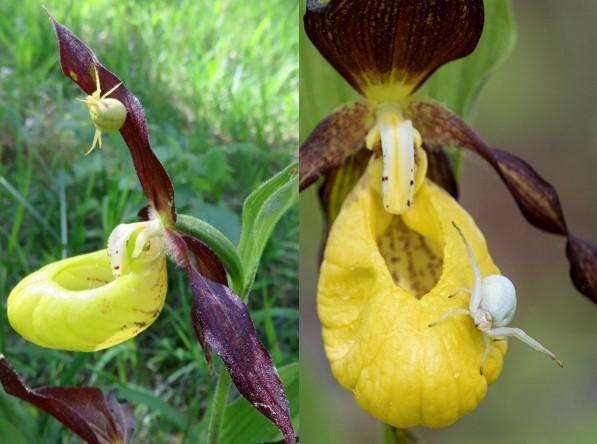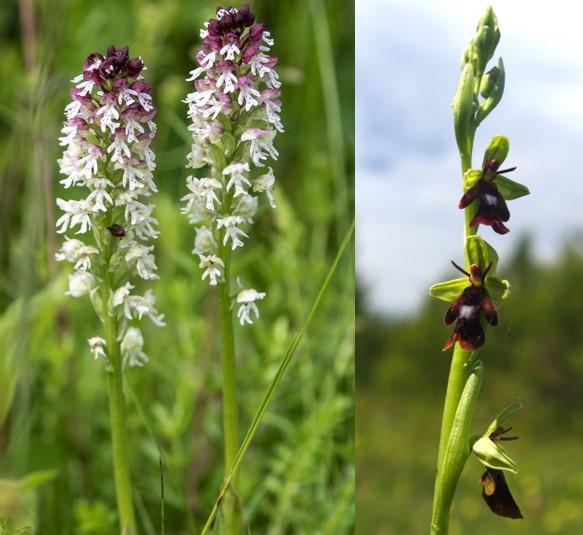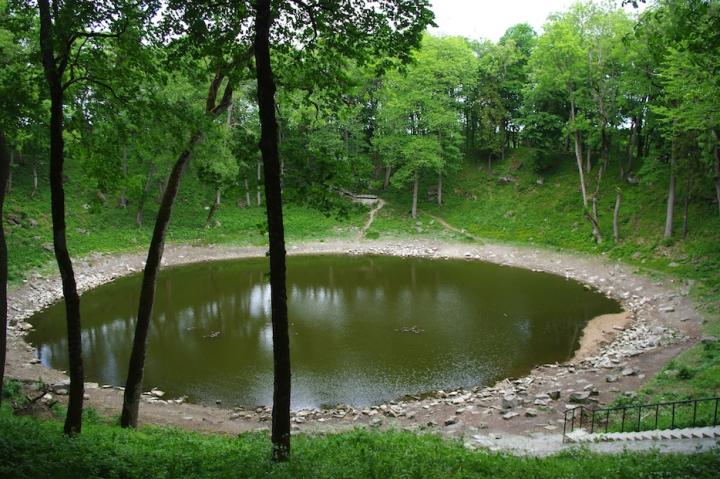Blog - Plant Hunting in Estonia (Pt3)
Following on from parts 1 and 2 we continue on the trail of discovering interesting plants as Dr Richard Milne and his team of plant scientists explore Estonia.
Author: Richard Milne, Editor: Tea Reinert
According to the epic Finnish national poem Kalevala, the child of the sun once fell from the sky. This myth probably centres around a real event, and thousands of years later, I took my wife, son and seven students to visit the spot where the son’s child landed, as part of an exploration of the country and its wild places.
In previous blogs I described our explorations of boreal woodlands and the majestic raised bog of Marimetsa in central Estonia. After leaving the bog, we continued towards the town of Virtsu, where we caught the vehicle ferry to the artificially linked islands of Muhu and Saaremaa. Landing on the smaller Muhu first, we soon came to our accommodation for the night, a rustic series of wooden huts plus a larger house, which the students would share. Soon, we were off exploring. Within a few paces of the house, orchids started to appear, first the curious green twayblade (Listera ovata) with is large, paired leaves and then one of the treasures of western Estonia, the military orchid Orchis militaris. Famously rare in Britain, it occurs in only three English sites, all of them carefully managed nature reserves. I recall saying this to an English speaker in western Saaremaa, who casually (and perhaps a little boastfully) replied “they grow by the roadsides here.” The species is so common in places that one must be careful not to tread on them. The individual flowers are remarkably beautiful, and like many Orchis species have a human-like shape to them. The lip provided the limbs, and its patterning recalls an old-fashion, decorated military uniform; the rest of the petals and sepals form a helmet.

I went on alone to some wet habitats by the main road, where I discovered several other plants from the “does occur in Britain but it’s very rare” category. These included a species of Carex, the fen violet Viola persicifolia, and another orchid, the creamy white Dactylorhiza incarnata subspecies ochroleuca. This species, known collectively as early marsh orchid, contains numerous subspecies, not all of them named. In Muhu and Saaremaa there is also a purple form which does not match any UK subspecies and might therefore be an undescribed subspecies. Estonian botanists are on the case, but there is so much hybridisation within this genus that it makes things very difficult. One comes across hybrids between the purple form and ssp ochroleuca from time to time, which are a beautiful flesh pink colour.
Later that evening, after supper, my wife, son and I retired to bed, but the students were eager for more botanical action. Darkness was not an issue, for this far north it remains light until close to midnight, during June. I deeply regret I was not with them for the moment when they came across a large patch of flowering lady’s slipper orchid (Cypripedium calceolus). This species was the showpiece of the whole trip and I had looked forward to introducing it to them myself, but these students had too much initiative of their own for that. Instead, they showed me the patch the following morning! This species is even rarer than the military orchid in Britain, reduced to literally a single surviving plant by the actions of collectors. Reintroduction projects have begun, with mixed results. In western Estonia, however, it continues to thrive, though it is far less common that other orchids like the military. The ‘slipper’ is a huge yellow inflated lip, into which small insects fall. These can then only escape by squeezing out past the sexual organs of the flower, passing first the female and then the male parts, hence transferring any pollen they may be carrying, before picking up more.
Any insect visiting this particular patch, however, faced an even greater hazard, for lurking on several of the flowers were crab spiders. These predators, which seem to be declining in Britain, sit on flowers waiting to pounce on pollinating insects. They can vary their colour like a chameleon, to help camouflage themselves. Here, lady’s slippers flowers seem to be a favourite haunt for them, for later that week we’d find other patches of the plants haunted by crab spiders, as well.

We made one more stop on the small island of Muhu, driving along a very dusty trach to a protected area on the northwest of the island, where a path led down past sparse woods to open scrubby meadows by the sea. Here, more lady’s slippers were to be seen, and the students made their first acquaintance with the fly orchid, Ophrys insectifera. This species is the most northerly member of a genus that evolved in the Mediterranean region, and remains bewilderingly diverse there. Four species reach the UK, but only O. insectifera reaches Estonia. Members of this genus have one of the most remarkable pollination strategies known anywhere: the flower pretends to be a female insect. It mimics a particular species in look, scent and feel. Randy males emerge in the spring intending to mate, and are fooled completely into trying to mate with the flowers. He only succeeds in getting orchid pollen bodies stuck to his head, whereupon he eventually gives up and flies off to be fooled by another flower, transferring the pollen.
Other interesting plants here included gromwell Lithospermum officinale and a path of wine-red flowered houndstongue Cynoglossum officinale, that latter tracked down by ten-year-old Lawrence. Lots of the stemless thistle Cirsium acaule, dotted the path sides. It is nicknamed “picnickers’ peril” because you really don’t want to sit on it. However, the prize find was waiting for us on the return journey, in scrub just west of the path, and this time it was me who found it. The burnt-tip orchid, Neotinea ustulata, is small in stature but very beautiful nonetheless. It gets its name from the very dark red colouration of the buds, which are gathered at the top of the inflorescence because like most species, the flowers at the bottom open first. My wife and I had been trying and failing to locate this species ever since we first came to these islands in 2006, so this was a major triumph, all the better for having a group of enthusiasts to share it with.
We then crossed to Saaremaa along a main road running along an artificial causeway, and continued to our final stop of the day, a place called Kaali. This site is unique within Estonia, and possibly to some extent the world, for I know of nowhere else where one can see, so clearly with the naked eye, the physical crater formed by a medium-sized meteor impact. Much of Estonia is pancake-flat, a result of two things: first, having been ground over by ice sheets for much of the past 2 million years; and second, a lack of recent tectonic activity, evidenced by the way the geological layers lie completely flat and unfolded nearly everywhere – except Kaali. Here, the layers are shattered in some places, and at all manner of angles in others. Approaching the crater, the ground is as flat as anywhere else, until suddenly one encounters a steep slope going up for about eight metres. At first, it looks like a small and wooded hill, but on reaching the rim, it reveals itself as a perfectly circular crater with raised sides, sloping steeply in the middle down to a circular lake that sits 22 metres below the rim, and hence about 14 metres below ground level beyond the crater. Water cannot escape the crater except through evaporation or very slow seepage through the ground, and so its level rises relentlessly through a wet autumn like a bath left running, until sometimes it spills over the crater rim. But we were there in June and the lake had retreated to the bottom. Where plants can grow here depends how much of the year they can tolerate underwater. Turkscap lily, Lillium martagon, makes a fine display on the slopes here.

The meteor that created the crater struck here sometime between 2400 and 8400 years ago and is one of the largest such events to have occurred anywhere in the world during human collective memory. It is believed that a 50-tonne rock travelling at around 50000 km/h caused the impact, entering the atmosphere at a 45-degree angle. Four lines from the Finnish poem Kalevala appear to capture the event: Downward drops the wayward Fire-child, Downward quick the red-ball rushes, Shoots across the arch of heaven, Hisses through the startled cloudlets
. The impact released about as much energy as the Hiroshima bomb, removing 80 thousand square km of rock, and incinerating everything within a six km radius. For any human beings standing far enough from the impact site to survive the explosion, it would have been utterly extraordinary, and a shared experience across a huge area of land. Following the fireball would have been a period of darkness as the sky filled with ash; this too is written into the Finnish legend. Some have even suggested links to more distant legends like that of the Golden Fleece. There is also archaeological evidence that the crater became a holy place, central to pagan worship. Even the Estonia tradition of huge bonfires in the long evenings of midsummer day, might have originated here. It is an extraordinary place in so many different ways.

